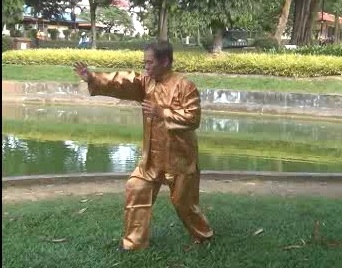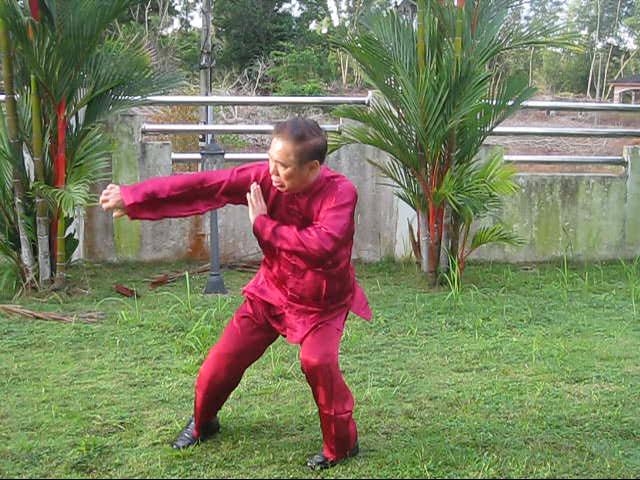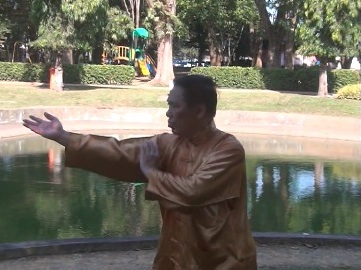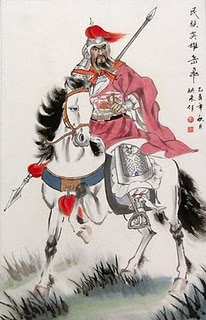MISCELLANEOUS SHORT QUESTIONS ON XINGYIQUAN

Xingyiquan is excellent for combat, especially in free sparring competitions today
Question
Is it good to practice certain types of Kung Fu in order to balance ourselves?
For example, if we need more confidence and decisiveness, is it good to practice Xinyiquan? And if we are too abrasive, is it good to practice Taijiquan or Baguazhang?
Sifu Mark Blohm
Answer
Yes, for other people it is good to practice certain types of kungfu to balance their character. For exampl, if they lack confident and decisiveness, it is good to practice types of kungfu like Xingyiquan, Choy-Li-Fatt and Hoong Ka Kungfu to boost their out-going qualities. If they are too abrasive, it is good to practice types of kungfu like Yang Style Taijiquan, Fujian White Crane and Northern Shaolin Huaquan to modulate their aggressive behavior.
However, for us our training, irrespective of whether it is Shaolin, Taijiquan, Xingyiquan, Baguazhang or any kungfu or chi kung styles will harmonize students’ character. If our students are too out-going to start with, the training will sober them. If they are too reserved, the training will stimulate them.
The two main reasons for this wonderful benefit, which may not be present in other schools, is our training of spirit and energy. When our spirit is purified and our energy harmonizes, we will attain physical, emotional, mental and spiritual balance. It is not for no good reason that we claim our arts to be elite.
Question
In the past, Xingyiquan masters would practice only San Ti Shi to develop internal force. Yiquan masters would probably practice San Ti Shi as well as the Three Circles Stance.
Both San Ti Shi and the Three Circles Stance are rather high in posture, emphasizing the development of chi flow. The flowing internal force would be similar to that of a Taijiquan or Baguazhang exponent.
Yet, Xingyiquan patterns are hard and explosive in nature. Did Xingyi exponents naturally learn at an earlier stage how to consolidate their flowing chi developed from San Ti Shi into hard internal force like that of Iron Wire?
Stephen
Answer
Besides San Ti Shi or Three-Body Poise, Xingyiquan as well as Yiquan masters also practiced other stances, but their main emphasis was Three-Body Poise.
Besides building up internal force, the Three-Body Poise using the extension mode and the corresponding mode, which we shall learn at the Xingyiquan course at the UK Summer Camp, also extends energy to the hands, and root exponents to the ground.
There are no special techniques in Xingyiquan, like in the Iron Wire Set, to consolidate flowing internal force derived from Three-Body Poise into hard, explosive force for combat. Then, from where Xingyiquan masters derived their hard, explosive force for which they were famous?
Like in Taijiquan but in a different way, Xingyiquan practitioners derive their hard, explosive force from their set practice, especially the Five-Elemental Fists. We shall learn this at the Summer Camp Xingyiquan course.
It is an ingenious method. Instead of hitting sand-bags and lifting weights as in many external arts, Xingyiquan practitioners practice their Three-Body Poise and the Five-Elemental Fists, and the internal force they develop is not only less demanding in their training and more powerful in combat, it also contributes to good health, vitality, longevity and daily efficiency.

Choy-Li-Fatt is excellent to boost out-going qualities
Question
I would like to ask about the relationship of Xingyiquan to the Spear.
The spear is known as "The King of Weapons". What are the crossovers between spear combat in general and empty-handed Xingyiquan in particular? How does the formidable reputation of the spear transfer into the combat efficiency of empty-handed Xingyiquan?
Sifu Andy Cusick
Answer
The spear is known as “the king of weapons”, and Xingyiquan is known as “kungfu for generals”. Throughout history the spear was the choice weapon of generals.
There are many cross-overs from the spear. In fact, all the five elemental fists of Xingyiquan came from spear techniques.
The spear is regarded as the king of weapons because technically the spear thrust is the most difficult to defend against. It was a tradition in the past that anyone learning a kungfu weapon should learn how to defend against or counter a spear thrust. The most important of unarmed Xingyiquan technique, pi-quan or chopping fist, despite its name, resembles a spear thrust.
Another important technique of the spear is circling. This circling movement of the spear is found in the spiral movement of beng-quan and zuan-quan, or crushing fist and spiral fist.
The spear is sometimes used to ward off an opponent’s weapon, followed with a spear thrust. This is found in pao-quan, or cannon fist, warding off an opponent’s attack or guard with one hand and striking him with the other.
The remaining of the five elemental fist, heng-quan or diagonal fist which is actually a horizontal chip, resembles a little known but deadly spear technique known as “bai-tou” or “shaking head”, which is slicing an opponent’s neck with a spear-head. In unarmed Xingyiquan, this became the heng-quan.
Even their subtle applications, which are secrets, are similar. If you slice your opponent’s neck with your spearhead, it is obvious and he can counter easily. But if you attack with a spear-thrust, and as he dodges sideway or wards off your attack, you circle round his defence and slice his neck, you often catch him by surprise. If you attack your opponent with a horizontal chop, it is obvious and he can counter easily. But if you attack with a thrust-palm, and as he dodges sideway or wards off your attack, you circle round his defence and slice his neck, you often catch him by surprise.
Question
In many Xingyi techniques I've seen, palm attacks seem to be prominent. Are there specific force training methods in Xingyi to develop powerful palms?
Sifu Markus Kahila
Answer
Fist attacks are prominent in Xingyiquan, not palms. “Xingyiquan fists, Baguazhng palms” is a common kungfu saying. Taijiquan, on the other hand, has a mixture of palms and fists.
There are no specific force training methods in Xingyiquan to develop powerful palms or fists. The force is developed through the Santi Poise and the flow-method of performing Xingyiquan sets. The Santi Poise accumulates the energy, performing Xingyiquan sets consolidates the energy into tremendous internal force.
Question
You've mentioned that Xingyiquan can help one train in the element of threat.
How can one practice against the element of threat in solo practice? Should we imagine our opponent threatening our life to increase the adrenaline and fear one feels when confronted in such a situation?
How can we translate this over into our daily lives? I feel this would be especially useful for those who have high stress jobs.
Stephen
Answer
The methods you suggest are third-class. Xingyiquan is first-class. It has far better methods.
It is even better that the methods are already incorporated into normal Xingyiquan practice. In other words, you don’t have to lift weights, hit sand-bags separately and work yourself into a frenzy to charge ferociously into opponents, and let opponents charge ferociously at you throwing punches and kicks wildly at you which you learn to condition yourself taking. These are third-class methods for ordinary soldiers. Xingyiquan uses first-class methods for generals.
Performing the Five Elemental Fists with pressing footwork provides force and threat at both the giving and the receiving ends. Without sacrificing your own safety, you press into your opponents forcefully and threateningly, letting him worry how to handle your attack instead of you worrying how to handle their attacks.
If your opponents are skillful enough to counter attack, you stop him immediately and continue your pressing attack, you do not retreat and let him take the attacking initiative. Xingyiquan is just pressing forward, with hardly any retreating. But you press forward without sacrificing your own safety.
One may read about such principles, but to acquire the skills and techniques to do so he must learn personally from a competent teacher, or better still from a master.

Heng-quan literally means diagonal fist, but is actually an horizontal chop
Question
Is Xingyiquan well-known for any particular weapons, like Taijiquan for the sword, Baguazhang for its knife, and Shaolin for its staff. I've heard that Xingyiquan was associated with the spear, but I've not yet run across any modern exponents practicing that weapon.
Frederick Chu
Answer
Xingyiquan is well known for the spear.
The two best known Xingyiquan masters, Yue Fei (12th century) and Ji Long Feng (17th century), were expert in the use of the spear.
Yue Fei (12th century), the inventor of Xingyiquan, used his metal spear on horseback to defeat the Tartars. Ji Long Feng, who popularized Xingyiquan, was so skillful with the spear that he was nicked named the “god of the spear”.
All the five elemental fists of Xingyiquan came from spear techniques.
Indeed, not may Xingyiquan practitioners today practice the spear. But there is a video on Youtube of a Xingyiquan master performing the Five-Elemental Spear. It is not impressive to watch but is very combat effective. My personal opinion is that the spear he uses is too flappy. It would be better if he had used a spear with a hard shaft.
It is a norm today that kungfu practitioners not only of Xingyiquan but of all styles do not pay much attention to classical weapons. Probably they think that classical kungfu weapons are no longer relevant as they are not used today for fighting. But there are still benefits learning classical weapons. Besides upholding tradition, learning classical weapons demonstrate more immediately some important lessons for unarmed combat.
Question
If I remember correctly, in Baguazhang there were not many patterns that were considered "compassionate" (as in comparison with Shaolin Kungfu), unless we use release force. For Xingyiquan, created to be as effective as possible on a battlefield, are there "compassionate" patterns, to spare the opponent?
In Baguazhang we learned to get behind an opponent very fast, and in my small experience, when circle walking one of the benefits is a strong all around awareness. In Xingyiquan, when on a battlefield, one could be attacked from all sides. Does training Xingyiquan also generate an all around awareness as in Baguazhang?
Tim.
Answer
In Xingyiquan if a practitioner has sufficient force all strikes are combat ending, or lead to combat ending strikes. There are no compassionate Shaolin chin-na or Wudang dim-mak. But, as you have rightly pointed out, a Xingyiquan exponent can be compassionate by not using full force, or he uses release-force.
By comparison Baguazhang is more compassionate. There are Baguazhang patterns like “Control a Running Horse”, “Black Bear Fells Tree” and “Golden Eagle Catches Chicken”, where a Baguazhang exponent keeps an opponent at bay, fells him onto the ground to subdue him, or grip his waist to disable his fighting ability.
Shaoln Chin-Na is very compassionate. Instead of breaking an opponent’s bones or damaging his internal organs, a Shaolin exponent uses chin-na to disable an opponent temporarily, and the latter can later recover by seeking the help of a competent healer.
Translating dim mak as a “death-touch” is due to shallow understanding. While it is true that a dim mak master could kill an opponent by apparently touching him, the main purpose of dim mak is to disable an opponent at the time of combat, but the latter could recover by seeking the help of a competent healer.
Yes, Xingyiquan training can generate a sense of all-round awareness. Santi Poise is a good exercise for this purpose.
Many people think that Xingyiquan is only going forward, and will be inadequate when attacked from a side or from the back. This is not true. As a complete martial art Xingyiquan is, a Xingyiquan practitioner can effective counter any attack from a side or the back.
This is already provided for in the two fundamental sets, Five-Elemental Continuous Fist and Twelve Animal-Form Continuous Fist. But as in all other kungfu sets, practitioners are not aware of the effective applications in the sets though they can perform the patterns beautifully. We shall be practicing these applications at the Xingyiquan course.
Question
When General Yue Fei developed and taught the "Kung fu for Generals," what qualities was he looking for in prospective students? What would make the General decide that this man would be taught Eagle Claw kung fu while that man would be taught Xingyiquan? Are there certain physical, mental, and/or spiritual qualities that lend themselves best to Xingyiquan?
Frederick Chu
Answer
There was no classical record for the answer, but I believe Marshal Yue Fei did not make any conscious choice of physical, emotional, mental or spiritual qualities when teaching some Xingyiquan and others Eagle Claw Kungfu.
To the generals, he taught Xingyiquan, and to the ordinary soldiers he taught Eagle Claw. It is helpful to know that Yue Fei did not teach them as a hobby. He taught them to serve expedient needs, so that the generals and the ordinary soldiers would be more efficient in battles. And this proved to be so in real life.
Question
You highlighted that the Xingyiquan offered at the UK Summer Camp would be an excellent preparation for those who wish to attend free sparring competitions. You mentioned if I am correct that Xingyiquan, among other styles would reflect Boxers and Kick Boxers way of fighting as most similar.
Could you please explain why Xingyiquan would suit the needs of students who wish entering competitions so good?
Sifu Roland Mastel
Answer
Your question is excellent not only for those who wish to take part in free sparring competitions but also for all kungfu practitioners who regard kungfu as martial art and not as gymnastics, dance or kick-boxing.
My earlier impression was that of all kungfu styles, Xingyiquan most reflects Boxers’ and Kick-Boxers’ way of fighting. As today most competitors fight like Boxers and Kick-Boxers in free sparring competitions, regardless of what martial arts they practice, Xingyiquan would be most useful to our competitors who wish to enter free sparring competitions and win.
This is implementing Sun Tzu’s perennial advice of knowing your enemy and knowing yourself, you will win a hundred battles out of a hundred. You know how your opponents fight and how you fight. Then you devise a way of fighting that your opponents do not know or cannot defend against so that you can easily defeat them. This is apply your planned and trained combat sequence relentlessly on your opponents.
This conclusion was made before I started to prepare myself to teach Xingyiquan. This conclusion was based on my wide understanding and experience of kungfu. I believed, and still believe, that if our competitors followed this strategy, they would have at least 95% chance of defeating their opponents in free sparring competitions. The main problem is that they may not follow this strategy though they honestly think they do.
But when I went deeper into Xingyiquan in preparation to teach it, I was amazed at its depth and discovered, besides other invaluable insights, an even better way for our competitors to win free sparring competitions. It is almost a joke when told to most other people: just apply a simple Xingyiquan sequence I am going to teach at the Xingyiquan course.
It excellently suits the needs of competitors wishing to win free sparring competitions. The two most important needs are to safe from opponents attacks, and to press in effectively with little chance of opponents escaping. The Xingyiquan sequence fulfills the two needs even more effectively than the earlier strategy I taught. And the sequence is so bafflingly simple!
This is only one of the many exciting benefits participants will get at the Xingyiquan course. There are so many exciting benefits that the five-day course can only introduce them to a taste of the benefits. Course participants will have to do a lot of training on their own after the course.
Question
Sifu, what is the highest attainment in Xingyiquan?
Sifu Matt Fenton
Answer
For most people, the highest attainment in Xingyiquan is superb combat efficiency.
Xingyiquan was invented for this purpose. It was invented by Yue Fei for generals to win battles in the battlefield. It was not invented with the aims of curing illness, improving health, enhancing vitality and longevity, or experiencing spiritual joys.
But for us in Shaolin Wahnam, we can have all these wonderful benefits besides combat efficiency. In fact, we have reverse the priority. Of course we want combat efficiency. We do not want to make a mockery of practicing a great martial art. But we place more importance on good health, vitality, longevity, mental freshness and spiritual joys.

Marshal Yue Fei was famous for his spear
Xingyiquan Questions and Answers
The questions and answers are reproduced from the thread 10 Questions to Sifu about Xingyiquan in the Shaolin Wahnam Discussion Forum.
LINKS
